#AIDS Quilt
Explore tagged Tumblr posts
Text




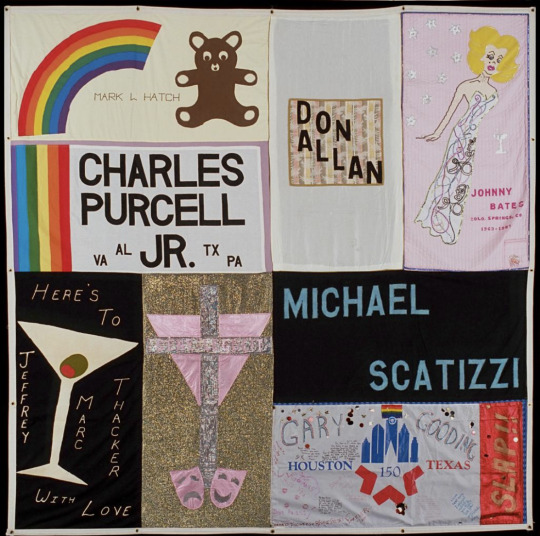
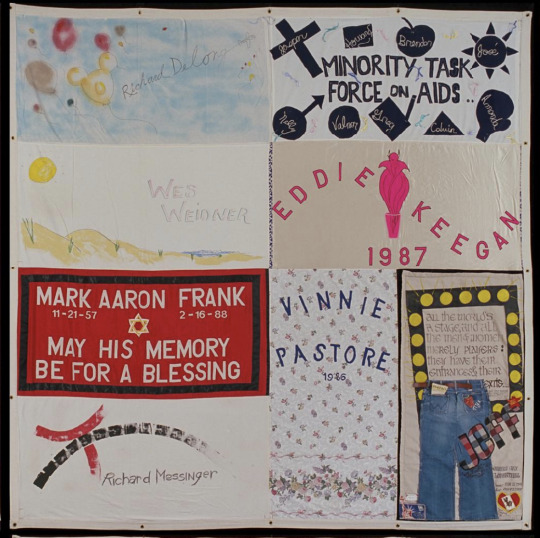
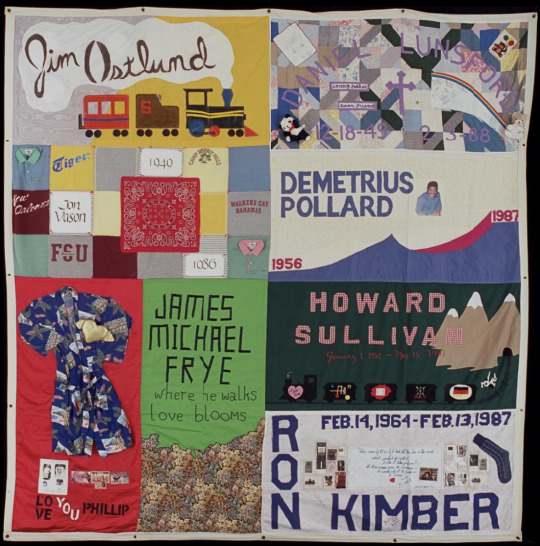


“Still loved."
AIDS QUILT SERIES | VIEW THE QUILT
#*aq#aids quilt#AIDS#HIV AIDS#aids memorial#aids activism#act up#world aids day#lgbtq#lgbt history#queer history#thank you to the person who found my tag.#and reblogged them all today.#it inspired me to make a new post.#they were so loved !#and they are still loved !#mine.
125 notes
·
View notes
Text


couldn't find this posted elsewhere so wanted to highlight this excellent article about Coretta Scott King's work & legacy, especially in loving Black queer people & working for queer liberation
image description: two screenshots from the Autostraddle article "How Coretta Scott King Leveraged MLK's Legacy to Fight for Gay Rights." the text reads:
In the mid-1980s, when President Ronald Reagan wouldn’t even acknowledge the disease, Scott King – with the help of her assistant Lynn Cothren, an openly gay man — used the King Center to create a welcoming environment for the LGBT community, especially queer black people who were suffering in the middle of a generational genocide from HIV/AIDS. After the death of a close gay friend, she hosted a day of memorial at the Center and encouraged participants to sew stitches on a panel that would become part of the AIDS memorial quilt.
On March 31st 1998, at the 25th Anniversary luncheon for the Lambda Legal Defense and Education Fund, King spoke out against strands of conservatism in black communities that had kept some members reluctant to join the gay rights movement. She stated, “I still hear people say that I should not be talking about the rights of lesbian and gay people and I should stick to the issue of racial justice… but I hasten to remind that Martin Luther King, Jr. said, ‘Injustice anywhere is a threat to justice everywhere.’ I appeal to everyone who believes in Martin Luther King, Jr.’s dream to make room at the table of brotherhood and sisterhood for lesbian and gay people.”
end image description.
#coretta scott king#queer history#black history#collective liberation#intersectionality#aids#hiv/aids#aids quilt#civil rights movement#lynn cothren#martin luther king jr#mlk jr#mlk day#mlk jr day#mac.txt#image described#misogynoir#homophobia#mac’s bookshelf
108 notes
·
View notes
Text

The Advocate, 1988. From cartoonist Gerard Donelan.
90 notes
·
View notes
Text
CALLING ALL QUEEN FANS: PROJECT
okay idk what just came over me but I was thinking about how many panels were made for Freddie for the AIDS Memorial Quilt and then I realized Joe Fanelli probably doesn’t have one
so I looked up the submission process and it is remarkably easy so godammit I’m making one and sending one in
and then I figured some people might want to be a part of this. Aside from sending the package, it doesn’t cost anything to submit so I’m not out here asking for donations. But you have to include a letter with it about the person and aside from a short bio/backstory, I thought it would be nice if people wanted to comment nice things to put at the end OR if anyone has ideas as to what to put on the panel (aside from his name) I will gladly take ideas (please, I am starting from a blank slate). Most things I think I’ll make out of fabric but I can also get away with fabric paint and sequins and stuff so pls do give object or design suggestions
Whoever writes something or gives a suggestion I’ll include as a participant at the end of the letter. If you comment something, please also indicate your preferred name or if you want to be Anonymous (state/country would be cool too!). Any ideas with no name indication, I’ll put you down as your user so if your Tumblr username is something you’d rather not have archived in the AIDS Memorial, do consider one of the other two options 😅
I’m doing this with or without other’s participation, I just thought the three Garden Lodge guys have never really gotten enough appreciation and it would be kind of a sweet somewhat community project. Maybe it’s the spirit of Christmas taking over me or something. So please do comment with whatever!
I’ll leave this up for at LEAST a week before I start buying supplies so if you’re seeing this days after it was posted don’t hesitate to still send something! And I’ll be sure to take picture proof when it’s done haha
Reblog for a bigger audience!! Happy holidays :)
53 notes
·
View notes
Text
One of my favorite movies of all time was added to the Library of Congress' National Film Registry today!
If you weren't there in those horrific early days of AIDS...if you've always wondered what the deal is with the Quilt...give this movie a look. It'll break your heart; it'll be worth it.
youtube
I first saw "Common Threads" in a film festival in Houston. I was wearing a skirt and had to use it to blot my face from all my tears. It helped inspire me to start an AIDS assistance program at my UU church. Really, it's worth seeing. And the music is so beautiful.
21 notes
·
View notes
Text

Panels of the AIDS Memorial Quilt on display at The Hudson Valley LGBTQ+ Center on World AIDS Day, 2024.
11 notes
·
View notes
Text
15 notes
·
View notes
Note
Ik you like talking about this and I’m actually like rly interested so what’s the aids quilt and triangle shirtwaist factory fire?
(It’s in your bio and as you probably know I hate looking stuff up and prefer talking to people-you don’t have to answer if you don’t want to)
*jumps up like the human equivalent of !!! and sprints to the computer to answer this properly with sources and shit* !!!!!!!!!!!
YOU WANT TO KNOW ABOUT THE TRIANGLE SHIRTWAIST FACTORY FIRE AND THE AIDS QUILT?????????? !!!!!!!!!!!! YOU ARE GOING TO REGRET THIS SO MUCH ASTER I'M SO EXICTED I'M NOT GOING TO SHUT UP FOR LIKE AN HOUR THIS IS AMAZING
(you have unlocked the Special Interests and now i won't shut up ever. :DDDDDDDDDD)
....well. I wasn't going to put a cut and then it got really, really long, so there's a cut about halfway through for the sake of peoples dashboards.
first up:
The Triangle Shirtwaist Factory Fire
(tw/cw: intentional endangerment of workers, death, suicide (unplanned/unintentional), graphic depiction of death)
short version: the triangle shirtwaist factory fire was one of the deadliest industrial disasters in US History and, I believe, the deadliest industrial disaster in the history of New York City. It was a key point in labor rights & union movements, and 146 people died, almost all recently immigrated women and girls between the ages of 14-23.
long version: at ~4:40 pm on march 25th, 1911, a fire broke out in a scrap bin under a cutting table in the triangle shirtwaist factory, which occupied the 8th, 9th, and 10th floors of the Asch building in new york city (manhatten, greenwich village specifically).
the factory produced shirtwaists, a popular kind of women's blouse. (it was a sweatshop, which is relevant for future reasons). It was owned by Max Blanck and Issac Harris, who had previously had four (? possibly 3) fires at other factories, and been investigated for them (it was suspected that one or more of those said fires were the result of arson by the owners). the workers were, for the vast majority, recently immigrated jewish & italian women and girls, from age 14 and up, but most were between 14 and 25. The oldest victim was 43. (of the victims whose ages are known). They earned $7-12 a week (approx. $190-326USD in 2020 dollars), or approx. $3.65-6.29 per hour in today's money. at the time of the fire, there were approx. 600 workers in the building.
the asch building was 10 floors in total, and the top 3 were occupied by the Triangle Shirtwaist Factory. The doors leading to the staircases were locked, to prevent workers leaving early or taking breaks. There were supposed to be 3 staircases, but there was only two; the city had allowed the owners to build a single fire escape in lieu of the third staircase. this fire escape may have been broken before the fire, and it was certainly broken afterwards. one of the staircases managed to be unlocked, but it became impassible either up or down within 3 minutes of the fire's start.
when the fire flared up, the first alarm was sounded by a passerby outside, who saw smoke coming out the windows at 4:45 pm.
the fire department arrived shortly after, but their ladders could only reach the 7th floor (the fire start on the 8th). some workers excaped via the roof (several years ago I heard a story about a guy who was teaching in the building next door and him and his students saw the people on the roof and were able to help them get over to the building the professor was in and not ontop of the burning one, but I can't find it again to validate it so take that with a grain of salt), and some got into the elevators while they were still working. the elevator operators were able to make 3 trips before the elevators stopped working from the excessive heat (the steel beams holding them bent and made it impossible to attempt).
inside the building, people on the 8th floor were able to warn people on the 10th floor by means of a telephone, but with the staircases locked there was no way to warn those on the 9th floor, and a survivor said (paraphrasing): ''the first warning of the fire arrived at the 9th floor at the same time the fire did''.
146 people died. 123 women and girls, the vast majority between the ages of 14-23, and 23 men and boys (I cannot find a clear age for them). 61 people died from jumping to their death or falling to their death out of the windows of the building. the fire department had nets meant to catch people, but velocity is velocity and the nets did nothing. people jumped out the windows hoping that the nets would catch them or they might survive, or that at least that had a better chance of survival than remaining inside the fire. 20 of these were on the fire escape & attempting to use it when it collapsed, dropping them 100ft to the sidewalk and killing them.
36 people died in the elevator shaft, after it started to break. (they attempted to jump/slide down the cables, and it did not work).
49 people burned to death or suffocated in the smoke.
the entire fire took 18 minutes.
The bodies of the victims were taken to Charities Pier (aka Misery Lane) to be identified. All but 6 were, and those 6 were buried together in the Cementer of the Evergreens in brooklyn (they were later identified by a historian named michael hirsch in 2011, after 4 years of research). they are now all buried together there, underneath a monument to the tragedy.
it caused a surge in the efforts of the International Ladies' Garment Workers Union, and eventually resulted in the passing of ~38 new york state labor laws.
The AIDs Quilt
(tw/cw: regan (referenced), death (nowhere near as bad as above))
The AIDs quilt is a memorial quilt commemorating those who have died of AIDs (at any point, not just during the AIDs crisis (fuck you ronald regan)), with panels sewn by family members and friends. It was begun in 1987 in San Fransisco by Cleve Jones. It is considered the largest community folk arts project in the world, and consists of nearly 50,000 panels honoring approx. 110,000 people.
Each panel is 6' by 3' (about the size of a standard grave), and four of them are sewn together to make large blocks that are then sewn/tied together. sometimes it goes on display, the most recent time in june 2022.
there is an interactive online version of the quilt, which you can find here.

here it is zoomed out as far as I could get

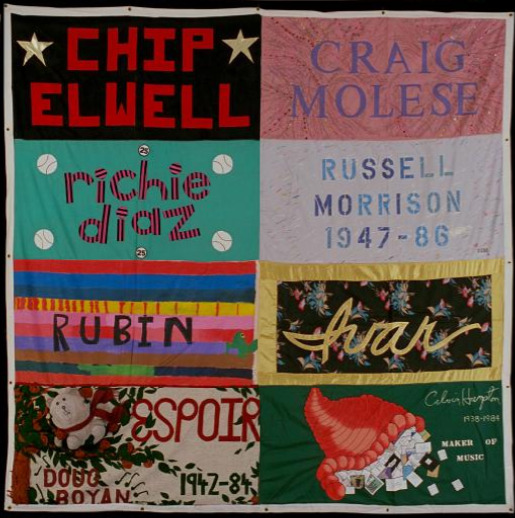

here are some of the larger blocks of the quilt
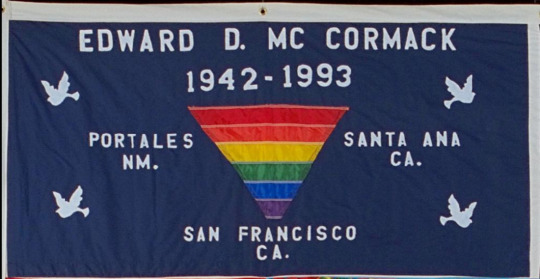


and here are some individual panels.
that's mostly all I have to say about it, but its incredible, and my favorite art project of all time.
(i don't have the spoons to add image descriptions to the photos, I am sorry, I will try to do it later when I remember)
#asks#amethyst aster#triangle shirtwaist factory#triangle shirtwaist factory fire#aids quilt#history#fuck you ronald regan. fuck him to fucking hell#(i will take ANY excuse to insult that man)
32 notes
·
View notes
Text

4 notes
·
View notes
Text
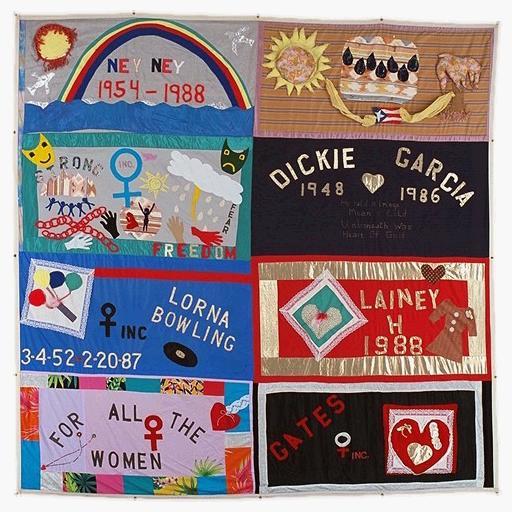



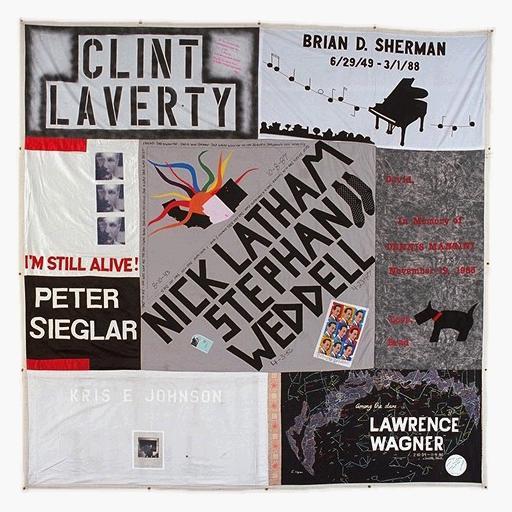



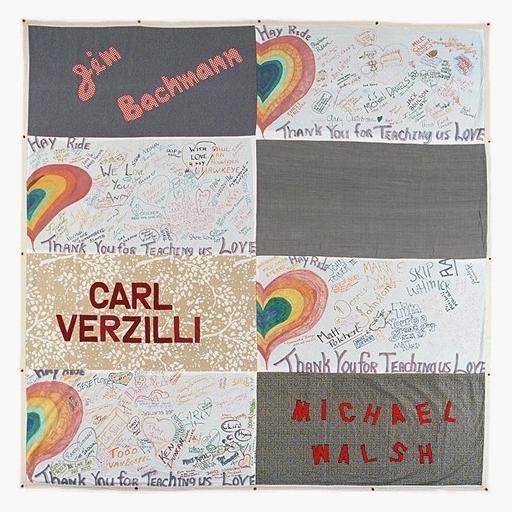
"let love replace fear through you."
AIDS QUILT SERIES | VIEW THE QUILT
#*aq#aids quilt#aids activism#hiv aids#act up fight aids#fight aids#aids#hiv/aids#aids epidemic#lgbtq#lgbtq history#lgbt history#queer history#i see that some folks have found my quilt tag & are reblogging.#& it inspired me to make another post before pride month is out.#thank you to everyone who reblogs one of these posts. i mean that.#thank you for taking a moment to love those who were taken.#anyway it was so hard to choose a tagline for this particular one...#' the face of the world has been changed forever. '#' our hearts will always be together. '#' i'm still alive! '#' for all the women. '#' for david who loved the minnesota prairie. '#' for everyone... love amy. '#& i feel you amy.#for everyone indeed.
478 notes
·
View notes
Text


15 notes
·
View notes
Text
Joe Memorial Panel Update
Guys…IT’S DONE. AND SHIPPED. (please keep in mind I am not at all a professional and I had to cut and sew everything by hand as I do not have a sewing machine. I also made the buttons 😃. I am a poor college student don’t @ me)


MORE INFO UNDER THE CUT
well this took a whole lot of work but I’m super proud of it. As of today it is in the hands of UPS to be delivered to California (not near the fires, dw). Between three and six months from now, it will be sewn into the Quilt and I WILL receive updates so anything important, I’ll report. The letter with the backstory, photos of him, and the panel maker information card will be archived in the Library of Congress American Folklife Center
the panel depicts his name and lifespan, an AIDS ribbon, an American flag, the box of chocolates he wore at Freddie’s silly hat party, a vegan symbol, a UK flag, a beet and lemon in reference to a dish he (according to Phoebe) invented (thanks to the one of you who dm’ed me those cookbook pages), a chef hat, a rainbow flag button and a button with a picture of him and Freddie
I wish I had put the chef hat more in that empty middle spot there but ah well (also, the memorial people will hem it so fear not of fraying)
IMMENSE thank yous to
@idontknowhowthisworked, Aarushi Doshi @impossibleglitterphantom, @delumieres, @plainxte and @freddie-mercury-rising
You have all been credited both in the letter I had to provide and on the back of the information form, as promised. And it’s literally entirely because of some of y’all that his name is even spelled correctly on there so pat yourselves on the back
Also big shoutouts to the signal boosters
@eileen-crys, @fanellifest, @kensingtonmarketstall, @stesichoreanpalinode, @an-audhd-brain-in-a-nts-world
And @your-one-day-ecstasy for offering to send me fabric
And thank you to all the vegans I polled on my main who helped make sure I used a proper vegan logo lol
I’m hoping this gets around to Phoebe…I posted it on Insta but it wouldn’t let me tag him, probably due to his account permissions. I tagged Brian and the official Queen account and included some hashtags which is about the best I can do
#queen#queen band#freddie mercury#Joe fannelli#joe fanelli#Gotta start phasing that one out guys#AIDS quilt#AIDS memorial#Peter freestone
30 notes
·
View notes
Text
I wrote something hard today. It's long. Please mind the content warnings, this one is heavy.
We Must Remember
ON DECEMBER 30, 2023 BY KAELENRHY/Kaija Rayne
Content Warnings: AIDS epidemic, queer death, queer abuse, child abuse, child neglect, mention of attempted rape, sexual harassment in the form of catcalling and whistling.
My generation of queers, the ones who came of age in the middle of losing most of a generation of our queer siblings… we don’t talk about it.
It’s got to be pretty obvious why we don’t. I can’t think of a queer person who knew they were queer who didn’t lose someone. And we all lost when it comes to some people. Freddie Mercury, for one, the lead singer of Queen. He died a day after announcing his diagnosis in 1991. He was 45 years old.
And there were so many others.
I’ve been aware of the lack of people who lived through it talking about this for a while. But it really brought it home to me when I asked my eldest, who is openly queer, if they knew what the AIDS quilt was. They didn’t. And generally, they’re interested in queer history, so tend to be better informed than a lot of queer youth about our collective history. It helps that I was a history teacher at one time and have always lived and breathed teaching it to anyone willing to learn.
So, here’s a story from a time I hope never to see again, but one which, when I look at the world, I deeply fear is coming back.
The moral panic we see now is like déjà vu for people like me. It was this exact same moral panic that caused medicine, and most of humanity, to completely ignore it as loved ones died. To treat human beings without the care or respect any human being deserves simply by drawing breath.
I grew up in the mountains in a very Christian cult-like atmosphere. It was honestly so close to being an actual cult. There really is such a minuscule difference. But it wasn’t an official cult. Just… very poor people backbiting each other any way they could. Praying like good people on Wednesdays and Sundays, but doing anything they wanted every other day of the week. You’d think with all the mountains around, they’d have anything better to do than gossip. But gossip ran as life’s blood. The internet didn’t yet exist in private homes in that piss hole in a snowbank. There were 3 churches in the town, and 6 bars. For 300 people. The closest store was a good 20-minute drive away, the closest library an hour.
Christ, it’s hard to remember these things. It’s been 33 ish years since this story happened in real life, and I still don’t want to revisit it.
But it’s important.
The memory of this day is ingrained on the inside of my skin. I can almost feel the heavy summer sun.
Sad Summer Day
I’m around 14 years old. I’m barefoot, because my family doesn’t see the point of buying shoes for summer wear. Feet toughen up just fine.
I’m wearing a fourth or fifth-hand t-shirt that is far too see-through and cut-off jean shorts. The tickling of the strings falling against my thighs as I walk is a soothing sensation to me. I’m finished with my chores, the horses are cared for, the dog fed, the abusive younger sibling has stopped screaming and throwing things at me because I wasn’t a suitable big sister and had gone to hide in her room. I’m an embarrassment to my allistic sister. I’m an embarrassment to my mother too. If she ever crawls out of the bottle long enough to give a shit about anyone. My brother lives elsewhere.
I stink. I don’t know that or understand it, but I stink. Getting clean means swimming in a scummy mountain lake most evenings. My mother hasn’t taught me anything about personal hygiene. She smokes like a damned chimney and always smells of booze. There is no way I don’t smell bad. We had bath nights once a week in the winter. The only reason I knew my period was a thing was school health class.
I hang around in the barn a lot. Or in the ancient maple tree in the pasture. Ar Bazara is my beautiful Arabian mare. Her hide is the stunning red of particularly vociferous sunsets. She often patiently lets me lie on her back with a book open on her rump while she grazes. My new goat, Esmerelda, is still adjusting to not being the house goat she was used to being. She’s miserable, mourning her friend and old life. I do what I can, but it doesn’t help very much. Goats grieve as much as humans do, maybe more so.
It’s my job, and escape, to walk to town and get the mail for my father, who works more than not, and can’t get to the post before it closes at 5pm. I have no idea when or if my mother will come stumbling in blind drunk.
I hope to see my friend, who lives at the top of the road to the post office. He hasn’t been feeling well. Wrapped up in a quilt in his mother’s rocking chair on the porch is how I’ve been finding him lately. It’s not very odd, it never gets truly warm in the mountains, so people in heavier clothes or a blanket around their shoulders isn’t uncommon. I think nothing of it.
He’s a relatively recent addition to my life. He moved into his mother’s house last year. Esmeralda had been his, but he’d asked me to take her last week and love her like he did. I really don’t see it coming, or maybe I don’t want to add up the clues.
He’s my only friend there. He looks much older to me, but in reality, is likely in his late twenties. He wears dark tortoise-shell rimmed glasses, always has interesting books to read and ideas to discuss. He’d made it out of the mountains, so has seen so much more of the world I long desperately to experience for myself. His butterscotch blond hair is always a curly mess, and he’s always running his hand through it. I hope I can sit on his porch steps, picking at splinters, while he tells me another story. I’m not supposed to talk to him. No one does in that town. We might catch it, if we do so much as look at him. But I like him, and he treats me like a combination of younger sister and wild animal. He always speaks in such a gentle, calm tone. A tone I never hear at home. Except for the day he gave me Esmerelda. He couldn’t talk through the tears he was trying to hide.
My aunt lives next to him and warns me away every time she sees me. I suppose she likely told my parents, but my parents either aren’t there or are drunk. He’s the only adult in that town other than my grandmother, who even sees me. Much less talks to me like I’m a person. My aunt is happy enough to take his money to make an extra portion of food for him when she cooks for her family every day. She drops it off on the porch and will only take the dishes back if they’re soaking in bleach water when she comes to get them.
I’m tanned dark brown. My mother kicks us out as soon as the snow melts and we’re expected to stay out until dusk. But I’ve got my summer colour, my hair is frizzy from the yearly perms, and sun-bleached. The stench of lemon juice in my hair is still strong, but I know better than to not use it every morning. Having my mother yank the black, spiral hairs out of my head hurts worse. But I hate the smell of lemon juice in my hair.
It’s a short walk to a mountain child. Though if you’d called me a child then it would’ve infuriated me.
I am still a child, a very naïve one. I only know the words gay and lesbian because I’ve read the OED cover to cover. But they’re nascent, formless concepts to me. I’m in the midst of my first crush. A girl in my class with the prettiest brown eyes and lush, curly hair. But, I’ve told no one.
There’s sand on the sides of the beaten-up tarmac of the road. I’m avoiding walking on the road itself because prickers from wild roses and blackberry bushes are vastly preferable to burnt feet.
In shade areas, the mounded sand is cool, a treat to dig my toes into, and there’s a place where rain makes interesting patterns in the sand. I stop there for a short time to look at the swirling patterns in that section. It’s different every time it rains.
The air is heavy, like a wet wool blanket, presaging another evening rainstorm. I cuss because it means I won’t get to swim that night. If I want to rinse off, it’ll be in the cold rain. Hopefully, there won’t be thunder. Loamy earth and the particular faintly metallic scent of slightly damp, lichen-covered stone coat my tongue with a musky taste. The lighter, higher sweet honey note of spreading dogbane makes the walk smell like a slice of heaven. They’re poisonous, of course, but they’re beautiful and one of my favourites. Bunchberry shows little red splashes of colour. Orange hawkweed is blossoming, and so is the milkweed. Soon there will be so many monarch butterfly caterpillars I’ll have to watch where I step. The unnatural stench of old, oft-tarred tarmacadam adds an unwelcome element of human activity to the interesting scents.
The forest sings, murmuring to each other with the slight breeze that’s the only coolness I’ll find unless it rains. And the creaks and groans of the poplar and birch trees provide a symphony. I walk by my grandmother’s house. She’s outside tending to her flowers and checking the bird feeders, so I wave instead of meandering over. My grandmother loves to talk. I’ll stop on the way back. I’m later than usual going to get the mail because of my sister’s abusive outburst.
My hands are stuffed in the far too small front pockets of my shorts. My hand is tightly wrapped around the mail key. I always hold it in my fist, my father says it’s a trust, and I don’t want to blow it. A hopped-up pickup truck with a custom paint job, jacked tires, and glass-packs roars by. The boys inside and riding on the bed cat call me, but I don’t understand it.
By this time in my life, my mother has dived into a bottle and never looked back. She taught me to drink on hanged man’s bridge when I was 11. Vodka. She’d already moved on to vodka from wine by that time. In a lot of ways, I didn’t have a mother anymore, if I’d ever really had one at all in anything other than the physical sense.
It’s 1990. Big hair is falling out of fashion, but I still have the perm that my (at the time) stick-straight hair needs to look like Bon Jovi.
It’s mid-summer, the sun is high in the sky and it won’t get dark until after 9 pm. I won’t have to go inside until 10. The voracious bugs are preferable to listening to another argument. And Gram will let me in and likely feed me. Maybe my brother will be there.
As long as I’m on my father’s or grandmother’s land by dusk, I don’t have to go inside. The crab apples aren’t quite ready, but I pick one to eat, anyway. The bitter, tart juice is still green-flavoured, but it fends off my hunger. I didn’t get to eat my food; I cleaned it up from where my sister had thrown it at the wall and took it out to the hens. I wonder if they like grape jam?
It’s not the first time I’ve been hungry. Hunger is basically my ground state. So much so that I don’t even feel it when I’m hungry.
I pause on hanged man’s bridge. Just for a moment, while I warily scan the church parking lots at the end of the road.
They’d kicked me out when I was 12, but if the minister sees me, I’ll get scolded for breathing. I’m lucky, the lots are deserted and I continue on my way.
There’s no tree cover here, but there is down by the water. The beavers are busily building a dam that the men will burn come fall. It makes me sad because I can see kits with their parents. Beaver has a lot of fat in the fall, so it’s good meat.
I turn left at the end of the road and walk past another not-so-distant relative’s house. I stop for a moment to pet the Percheron workhorses who obligingly hang their heads over the fence so I can pluck handfuls of fresh green grass for them. Their slobber on my hands is green, but it doesn’t register as anything other than something to wipe off on my butt. I love these gentle giants, but the sun is lower in the sky, so I hurry on. I pass two more relatives’ houses. I have a tendency to walk with my gaze on the ground, partially to make sure I don’t step in anything, but partially in hope of finding a new, interesting stone or a bone for my collections.
So, I just… don’t notice. I’m in my own head a lot, working on stories. I started writing 3 years before.
There’s a sharp, rattling sound I associate with caster wheels and I look up.
My friend isn’t on the porch and he can’t tell me any more stories.
The glaring canary yellow of haz-mat suits screams brightly from his faded house. They look like aliens to me. Fierce, terrifying aliens. We don’t have TV, or rather, we don’t have TV reception, so the only reason I know what the suits are is because of my long habit of reading encyclopedias.
One of them is roughly handling his body as the other wraps a second roll of cellophane around him, over and over. They’re great yellow spiders as they finish wrapping my friend in cellophane and put him on the emergency bed from the ambulance. There aren’t any lights on, it’s turned off, and the driver has his booted foot hung out the window while he looks at a playboy. He whistles at me and winks. I hear one of the aliens say the body bags are too expensive to waste on trash. One of them fetches a floral sheet from my friend’s home. They wrap him in that.
I stand there like a rock has landed on my head.
I’m mute. I can’t even make myself move to go yell at them for laughing over my friend’s body and trading slurs for him as if it’s a game. Even if I were brave enough to confront adults. Which, I am not.
They very carefully take the gurney to the ambulance, avoiding all possible touch with the cellophane cocoon. The straps are so tight around my friend’s body that if he could feel them, he would have cried.
The doors make a doubled, muffled thump and the engine of the ambulance starts. It jerks me into movement, but I’m too late. They drive off.
They haven’t closed his kitchen door. So I do it, thinking in that odd way that he’ll be sad when he comes back to find it left open. I never have seen inside his house and I don’t breach his privacy as I close the door.
I have no way to lock it, and he told me he hasn’t any family left.
I step quickly down the top of the searing hot grey metal culvert cover to my aunt’s large backyard. I’m grateful to not run into my cousins. One of whom has already tried to rape me. I can fight him off if I have to, again, but all I need is to escape. I hopscotch across the brook and into the old potato field. I leap like a yearling deer from one mound to the next before I can disappear myself into the forested lands on my dad’s property. I practically live in the forest, and my friend’s habit of treating me like a wild animal isn’t off. I am.
The next thing I clearly remember is hugging Esmerelda’s neck, finally understanding why he’d asked me to take her.
Finally understanding a lot of things a 14-year-old probably shouldn’t have to think about.
I never did get the mail that day. I had to scour the area I’d walked to find the mail key I’d always been so careful not to drop.
Years later, when I was 19, and I’d escaped those fucking mountains, I was in university and doing very well. The only semester I didn’t hit the president’s list was the semester I had mono, and I still made dean’s.
I and a couple of others had recently been thrilled to get the B added to the LG group (lesbian and gay). Bisexual erasure is still prevalent, and it was worse then.
It was meeting night for the club, and one of my friends, one of the first openly gay men I knew while understanding what that meant, had a square of heavy white cloth. He explained it was for a project to remember those we’d lost to AIDS.
I took it home to my dorm room that night and feverishly embroidered a little grey goat wearing a green collar and a shiny gold jingle bell. I’ll never know why he named her Esmerelda.
The last time I visited those mountains, just before our move to Canada… I walked over with my eldest on my hip to look at my friend’s house. The door gaped open like a missing tooth in a smile, but no human scavengers had touched anything. (In those mountains, scavenging is a way of life. It’s a testimonial to their prejudice and discrimination that his home wasn’t pillaged.) The roof had fallen in at some point, always a danger in those mountains, from the weight of snow. The porch step I’d sat on to listen to his stories had fallen off and lay almost rotted through. I stood there looking at his house for probably longer than I remember. They’d closed the post office. The workhorses had been sent to make dog food when the man of the house died and his widow couldn’t care for them. Pound for pound selling them to the butcher was more practical.
My mother sold Ar Bazara just before she left my father. My beautiful mare had died at her new owners from pneumonia not long after I’d graduated high school.
Fall asters bloomed, making shockingly bright splotches of colour around his house. No one would even go close enough to do the neighborly thing and mow the tiny area of land that went with the house. Perception was everything to those people. It wouldn’t do to be perceived as less than a ‘good Christian’. So it spoke volumes that no one had shoveled the roof or mown the lawn. The only way people survive up there is by banding together when needed. My cousins may shoot each other (true fact) but they’ll band together if someone threatens from outside.
My grandmother was gone. Still with us in the flesh, but Alzheimer’s took her from us long before she actually died. She didn’t even remember I had a kid.
My father had cut the ancient maple tree I’d loved so much for firewood years before, sometime when I was in uni.
There weren’t any horses anymore. Esmeralda had gone. She never recovered. The sweet, gentle goat I’d agreed to love turned vicious and mean. I didn’t know how to help her and no one I dared ask could help. My father made me get rid of her when she butted him in the knee.
I kissed my little one’s head when he reached up curiously to touch a tear on my cheek. I doubt he’d ever seen me cry before that. I don’t cry easy. My therapist has me working on relearning how to cry.
That isn’t a problem right now. I can barely see to type. No matter how many years pass, I can’t forget the tearing, sticky sound of the cellophane as they wrapped my friend up. I can’t forget the things they said about him while wearing those stupid haz-mat suits. Which they hadn’t even been wearing correctly. I can’t forget and it’s so bloody hard to remember these things, much less talk or write about them.
Within my lifetime, we’ve seen amazing changes in queer rights. But I, and a lot of older queers, are watching the current political climate of the world and… we could so easily lose everything we’ve gained.
Trans people are always the canaries in the coal mine; always the ones sacrificed first. They will come for the rest of us.
If you’re queer, don’t ever fall into the trap of thinking it’s ancient history. I’m currently 47. This day happened 33 years ago. Don’t fall into the morass of thinking our rights can’t be stripped from us.
They can. And I fear, deeply, that they’ll strip our rights from us again. We could so easily fall down the slippery slope until all of us are disrespected as my friend was. He died alone. And I suppose I should be grateful my aunt noticed right away, that anyone noticed at all. He was a pariah. He’d come home to die after his partner did, only to face massive social exclusion by people he’d grown up with. My aunt only fed him for the cash. Even then, barter was still common. Hard cash wasn’t always easy to get.
I went to the cemetery to try to find his grave and plant some flowers on it. I found where it was supposed to be. Right on the very edge next to the pine forest. Just a slight depression marking what was likely a cheap pine coffin, if they even paid him that much respect. There wasn’t a crematorium anywhere close by. So they’d stuck him as far away from the other dead people as possible. As if the dead could catch it. We didn’t name it. It was the illness variety of the boogeyman. If you don’t name it, it can’t find you.
Starflower had grown to cover the area, so at least I know every spring he has a blanket of small, ethereal white flowers. We lost most of a generation of queers due to medical negligence and reprehensible cruelty from humans to other human beings.
But these stories shouldn’t die with us. Queer youth need to understand what we lived through so they don’t get too complacent. I’ve fought for queer rights since I was 14 years old.
My eldest can just be openly queer. Something I’ve never been able to be except for a few short years in university.
I don’t want to see us lose our rights again.
I don’t want another misunderstood, abused, hurting queer kid to have to watch as their only friend is wrapped in cellophane and denied the honour of a body bag. Denied the honour of a decent grave with a simple headstone.
We’re already losing queer rights. Please don’t be complacent.
Phew, so… I’m a sobbing mess. If my work of words touched you, please consider a tip or becoming a patron. We live in poverty. My husband is recovering from one of the likely three back surgeries he needs for his broken back. We have two autistic/ADHD kids and finding a job is impossible. I’ve been looking since January 15th, 2023. I have $50/$1220 I need for rent for January. We can’t get any government aid because I’m an immigrant.
Far too many queer creatives live in poverty. I’ll do a series of these memories as I can. They’re very emotionally difficult for me to write, but I feel they’re very important things.
http://ko-fi.com/A630KKM
https://www.paypal.me/KaelanRhy
6 notes
·
View notes
Text
Every once in a while I remember Roy Cohn's patch on the AIDS Quilt and it makes me emotional every time.

Roy Cohn was a massive piece of shit: one of the instigators of the Lavendar Scare and arguably responsible for the rise of Trump - I dunno, having this patch as his legacy seems fitting.
6 notes
·
View notes
Text
the word “quiltbag”
(just posted this over at Autisticat on facebook, & copying it over here) i just found out the other day that something i thought was common knowledge might not be. (do any of you do that too, where you assUme that everyone else knows things? for me i think a lot of it is that i often seem to be the last person to know!) note: this isn't specifically about the autistic community. but i, like many of the other autistic + otherwise neurodivergent people i know, are also part of the quiltbag community. the word quiltbag is an alternative to the initialisms LGBTQ, LGBTQ+, LGBTQ2S, etc. i first learned "quiltbag" in the 00s, i think. i don't know who coined it, but the person who pointed me to it told me about the symbolism that resonated with her. unlike initialisms, quiltbag is also a pairing of two words that describe a real thing, a quilt bag. also called a piece bag, a quilt bag holds the cut pieces that will be sewn together into a quilt. and "quiltbag" holds ALL the pieces that form the community. and the word quilt? oh my goodness, to me that feels like a gentle nod of remembrance for everyone we've lost to aids, because it evokes the aids quilt. (i was in my 20s when the aids hit hard in the us.) less emotionally: it's also easy to say! tl;dr: i love the word quiltbag because of all the meaning and symbology -- and i had NO CLUE this wasn't common knowledge, oops!🙀💜xo
11 notes
·
View notes
